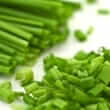Background
- Chives are native to Europe, Asia, and North America. They are commonly used as cooking herbs to give a mild onion flavor to many foods, including salads, soups, vegetables, and sauces. Chives (Allium schoenoprasum) belong to the Liliaceae family, although they are sometimes grouped together with the onion family (Alliaceae).
- Allium herbs such as Chinese chives, garlic, and onion contain the element sulfur, resulting in the strong smell of these herbs.
- Chives and members of the onion family have been used for many centuries for their flavoring value in food and for their medicinal properties, including relief from sunburn and sore throat.
- Chives may have antibacterial, antifungal, antiviral, and some anticancer effects. Studies have found a possible link between the consumption of Allium vegetables, including chives, and a reduced risk of prostate cancer.
- At this time, there is not enough evidence supporting the use of chives for any medical condition.
References
- Bianchini, F. and Vainio, H. Allium vegetables and organosulfur compounds: do they help prevent cancer? Environ Health Perspect. 2001;109(9):893-902. View Abstract
- Fenwick, G. R. and Hanley, A. B. The genus Allium. Part 2. Crit Rev.Food Sci Nutr. 1985;22(4):273-377. View Abstract
- Fenwick, G. R. and Hanley, A. B. The genus Allium--Part 3. Crit Rev.Food Sci Nutr. 1985;23(1):1-73. View Abstract
- Guohua, H., Yanhua, L., Rengang, M., Dongzhi, W., Zhengzhi, M., and Hua, Z. Aphrodisiac properties of Allium tuberosum seeds extract. J Ethnopharmacol 4-21-2009;122(3):579-582. View Abstract
- Held, D. W., Gonsiska, P., and Potter, D. A. Evaluating companion planting and non-host masking odors for protecting roses from the Japanese beetle (Coleoptera: Scarabaeidae). J Econ.Entomol. 2003;96(1):81-87. View Abstract
- Hsing, A. W., Chokkalingam, A. P., Gao, Y. T., Madigan, M. P., Deng, J., Gridley, G., and Fraumeni, J. F., Jr. Allium vegetables and risk of prostate cancer: a population-based study. J Natl.Cancer Inst. 11-6-2002;94(21):1648-1651. View Abstract
- Hsu, W. Y., Simonne, A., and Jitareerat, P. Fates of seeded Escherichia coli O157:H7 and Salmonella on selected fresh culinary herbs during refrigerated storage. J Food Prot. 2006;69(8):1997-2001. View Abstract
- Jordão CP, Cecon PR Pereira JL. Evaluation of metal concentrations in edible vegetables grown in compost amended soil. International Journal of Environmental Studies 2003;60(6):547-562.
- Lam, Y. W. and Ng, T. B. A monomeric mannose-binding lectin from inner shoots of the edible chive (Allium tuberosum). J Protein Chem 2001;20(5):361-366. View Abstract
- Qiao, Y., Galvosas, P., and Callaghan, P. T. Diffusion correlation NMR spectroscopic study of anisotropic diffusion of water in plant tissues. Biophys.J 2005;89(4):2899-2905. View Abstract
- Sneeden, E. Y., Harris, H. H., Pickering, I. J., Prince, R. C., Johnson, S., Li, X., Block, E., and George, G. N. The sulfur chemistry of shiitake mushroom. J Am.Chem Soc. 1-21-2004;126(2):458-459. View Abstract
- Stajner, D., Canadanovic-Brunet, J., and Pavlovic, A. Allium schoenoprasum L., as a natural antioxidant. Phytother.Res 2004;18(7):522-524. View Abstract
- Stajner, D., Igic, R., Popovic, B. M., and Malencic, Dj. Comparative study of antioxidant properties of wild growing and cultivated Allium species. Phytother.Res 2008;22(1):113-117. View Abstract
- Wang, H. X. and Ng, T. B. Ascalin, a new anti-fungal peptide with human immunodeficiency virus type 1 reverse transcriptase-inhibiting activity from shallot bulbs. Peptides 2002;23(6):1025-1029. View Abstract
- Yamato, O., Kasai, E., Katsura, T., Takahashi, S., Shiota, T., Tajima, M., Yamasaki, M., and Maede, Y. Heinz body hemolytic anemia with eccentrocytosis from ingestion of Chinese chive (Allium tuberosum) and garlic (Allium sativum) in a dog. J Am.Anim Hosp.Assoc. 2005;41(1):68-73. View Abstract







